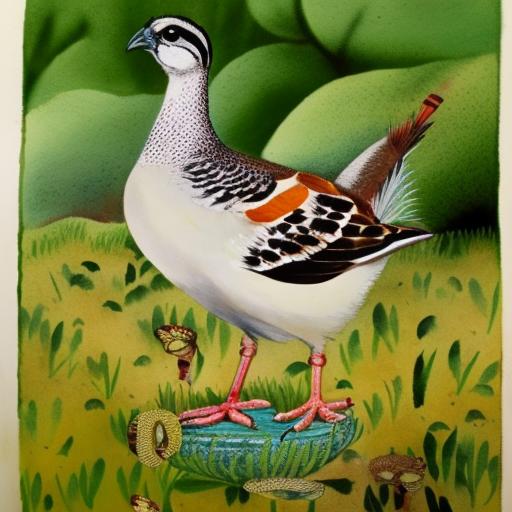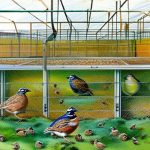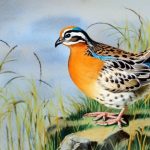Quail breeding is a fascinating and rewarding endeavor that requires a good understanding of the breeding process. Quails are small game birds that are known for their fast growth and high egg production, making them an ideal choice for breeders. Understanding the breeding behavior of quails is essential for successful breeding. Quails are monogamous birds, meaning they form long-term pair bonds with their mates. This makes selecting the right breeding pair crucial for successful breeding. Quails are also prolific breeders, with females capable of laying up to 300 eggs per year. Understanding the reproductive cycle of quails is important for maximizing egg production and ensuring successful hatching. Quails reach sexual maturity at around 6-8 weeks of age, and breeding usually occurs in the spring and summer months. Understanding the breeding behavior and reproductive cycle of quails is essential for successful breeding.
Quail breeding also requires an understanding of the incubation process. Quails are known for their strong maternal instincts, and the female quail is responsible for incubating the eggs and caring for the chicks once they hatch. Understanding the incubation process is important for ensuring successful hatching and healthy chicks. Quail eggs typically take around 17-18 days to hatch, and the chicks are precocial, meaning they are born with their eyes open and are able to feed themselves shortly after hatching. Understanding the incubation process and the care of the chicks is essential for successful quail breeding.
Key Takeaways
- Quail breeding requires understanding of their natural mating behaviors and reproductive cycles
- Select breeding pairs based on health, temperament, and genetic diversity to ensure strong offspring
- Create a breeding environment with proper lighting, temperature, and nesting materials to encourage mating and egg laying
- Provide a diet high in protein, calcium, and vitamins to support the breeding pair and their developing eggs
- Monitor breeding pairs for signs of aggression, infertility, or egg-related issues and make adjustments as needed to ensure successful breeding
Selecting a Breeding Pair
Selecting the right breeding pair is crucial for successful quail breeding. When choosing a breeding pair, it is important to select birds that are healthy, genetically diverse, and have good reproductive potential. Look for birds that are active, alert, and have bright eyes and clean feathers. Avoid birds that appear lethargic or have any signs of illness or injury. It is also important to select birds that are genetically diverse to avoid inbreeding and maintain genetic diversity within the breeding population. Inbreeding can lead to genetic abnormalities and reduced reproductive success, so it is important to select breeding pairs that are not closely related.
When selecting a breeding pair, it is also important to consider the reproductive potential of the birds. Look for birds that are in good body condition and have a history of successful breeding. Avoid birds that have a history of infertility or low egg production. It is also important to consider the age of the birds when selecting a breeding pair. Younger birds may have better reproductive potential, while older birds may have reduced fertility. Selecting the right breeding pair is crucial for successful quail breeding, so take the time to carefully evaluate potential breeding pairs before making a decision.
Creating the Right Environment for Breeding
Creating the right environment for breeding is essential for successful quail breeding. Quails are ground-dwelling birds that require a well-designed breeding environment to thrive. When creating a breeding environment for quails, it is important to provide adequate space, shelter, and nesting areas. Quails are social birds that prefer to live in groups, so it is important to provide enough space for the birds to move around and establish territories. A spacious and well-ventilated enclosure will help reduce stress and aggression among the birds, which can improve breeding success.
Quails also require shelter and nesting areas to feel secure and comfortable. Provide shelters such as wooden boxes or artificial shelters to give the birds a place to hide and rest. Nesting areas should be provided with suitable nesting materials such as straw or hay to encourage egg laying and incubation. It is important to provide multiple nesting areas to prevent competition among the birds and ensure that all females have access to a suitable nesting site.
In addition to space, shelter, and nesting areas, it is important to provide a suitable substrate for the birds to walk on. A substrate such as sand or wood shavings will help keep the birds’ feet clean and prevent foot injuries. Creating the right environment for breeding is essential for successful quail breeding, so take the time to design a well-structured and comfortable breeding environment for your quails.
Providing Proper Nutrition for Breeding Quail
Providing proper nutrition for breeding quail is essential for ensuring reproductive success and healthy offspring. Quails require a balanced diet that provides all the essential nutrients they need for breeding, egg production, and chick rearing. When breeding quail, it is important to provide a high-quality commercial quail feed that is specifically formulated for breeding birds. A good quality quail feed will provide the right balance of protein, vitamins, minerals, and energy to support reproductive health and egg production.
In addition to a commercial quail feed, it is important to provide access to fresh water at all times. Water is essential for egg formation, chick development, and overall health and well-being of the birds. Ensure that the water is clean and free from contaminants to prevent any health issues in the breeding quail.
It is also important to supplement the quail’s diet with fresh greens, fruits, and vegetables to provide additional nutrients and variety in their diet. Leafy greens such as spinach, kale, and lettuce are rich in vitamins and minerals that can support reproductive health in breeding quail. Fruits such as berries, apples, and melons can also be offered as treats to provide additional nutrients and enrichment for the birds.
Providing proper nutrition for breeding quail is essential for ensuring reproductive success and healthy offspring. Take the time to provide a balanced diet that meets all the nutritional needs of your breeding quail to support their reproductive health and overall well-being.
Monitoring the Breeding Process
Monitoring the breeding process is essential for ensuring successful quail breeding. Keep a close eye on your breeding quail to monitor their behavior, egg production, and overall health. Regularly observe your quail to look for signs of mating behavior, such as courtship displays and copulation. Mating behavior is an indication that your quail are ready to breed, so monitor their behavior closely during the breeding season.
In addition to behavior, it is important to monitor egg production in your breeding quail. Keep track of how many eggs each female lays and monitor any changes in egg production over time. A decline in egg production could be a sign of stress, illness, or other health issues that need to be addressed.
It is also important to monitor the overall health of your breeding quail. Keep an eye out for any signs of illness or injury, such as lethargy, loss of appetite, or abnormal droppings. Regular health checks will help you identify any health issues early on and take appropriate action to address them.
Monitoring the breeding process is essential for ensuring successful quail breeding. Keep a close eye on your breeding quail to monitor their behavior, egg production, and overall health to ensure a successful breeding season.
Caring for the Breeding Pair and Their Offspring

Caring for the breeding pair and their offspring is essential for ensuring their health and well-being throughout the breeding process. Provide a clean and comfortable environment for your breeding quail with access to fresh water at all times. Regularly clean their enclosure to prevent the buildup of waste and contaminants that could affect their health.
In addition to providing a clean environment, it is important to provide proper nutrition for your breeding quail to support their reproductive health and overall well-being. Offer a balanced diet that includes a high-quality commercial quail feed, fresh greens, fruits, and vegetables to meet all their nutritional needs.
Once the eggs hatch, it is important to provide proper care for the chicks to ensure their health and survival. Keep the chicks warm and dry with access to chick starter feed and fresh water at all times. Monitor the chicks closely for any signs of illness or weakness and provide any necessary care or treatment as needed.
Caring for the breeding pair and their offspring is essential for ensuring their health and well-being throughout the breeding process. Provide a clean environment, proper nutrition, and attentive care to support your breeding quail through each stage of the breeding process.
Troubleshooting Common Breeding Issues
Breeding quail can sometimes be challenging due to various issues that may arise during the process. One common issue that breeders may encounter is low egg production or infertility in their quail. This could be due to factors such as stress, poor nutrition, or age-related decline in fertility. To address this issue, ensure that your quail are provided with a balanced diet, a clean environment, and proper care to support their reproductive health.
Another common issue in quail breeding is poor hatchability or low chick survival rates. This could be due to factors such as improper incubation conditions, genetic abnormalities, or inadequate care of the chicks after hatching. To improve hatchability and chick survival rates, ensure that your incubation conditions are optimal with proper temperature and humidity levels. Additionally, provide proper care for the chicks after hatching with access to chick starter feed, warmth, and protection from predators.
Aggression among breeding pairs can also be a common issue in quail breeding. This can lead to injuries or stress among the birds, which can affect their reproductive success. To address aggression among breeding pairs, provide enough space and shelters in their enclosure to reduce competition and establish territories among the birds.
By troubleshooting common breeding issues such as low egg production, poor hatchability, or aggression among breeding pairs, you can improve your chances of successful quail breeding and ensure the health and well-being of your birds throughout the process.
In conclusion, understanding quail breeding requires knowledge of their reproductive behavior, selecting suitable breeding pairs, creating an appropriate environment for breeding, providing proper nutrition, monitoring the process closely, caring for both parents and offspring attentively while troubleshooting common issues that may arise during this process. With this comprehensive understanding of quail breeding practices in place breeders can ensure successful outcomes in their endeavors with these fascinating game birds.
If you’re looking to start breeding quail, you’ll need to ensure you have the right setup for your birds. Poultry Wizard offers a helpful guide on the Producers Pride Sentinel Chicken Coop, which can be a great option for housing your quail. Additionally, their article on breeding geese discusses the incubation period for goose eggs, providing valuable insights into the hatching process. Check out their website for more information on poultry care and breeding techniques. Learn more about the Producers Pride Sentinel Chicken Coop here.
FAQs
What is a breeding pair of quail?
A breeding pair of quail refers to a male and female quail that are kept together for the purpose of producing offspring. Quail are popular for their eggs and meat, so many people raise them for breeding purposes.
Where can I get a breeding pair of quail?
You can get a breeding pair of quail from local breeders, hatcheries, or poultry farms. You can also find them at agricultural fairs, poultry shows, or through online marketplaces.
What should I look for when selecting a breeding pair of quail?
When selecting a breeding pair of quail, look for birds that are healthy, active, and free from any signs of illness or injury. It’s also important to choose birds that are of breeding age and have good genetic traits for egg production and meat quality.
How do I introduce a breeding pair of quail to each other?
When introducing a breeding pair of quail, it’s best to do so in a neutral environment where both birds have plenty of space to move around. Keep an eye on their behavior to ensure they are getting along and not showing signs of aggression.
What do breeding pairs of quail need in terms of housing and care?
Breeding pairs of quail need a suitable housing setup that provides them with enough space to move around, nest boxes for laying eggs, and protection from predators. They also require a balanced diet, access to clean water, and regular monitoring for any signs of illness or injury.
Meet Walter, the feathered-friend fanatic of Florida! Nestled in the sunshine state, Walter struts through life with his feathered companions, clucking his way to happiness. With a coop that’s fancier than a five-star hotel, he’s the Don Juan of the chicken world. When he’s not teaching his hens to do the cha-cha, you’ll find him in a heated debate with his prized rooster, Sir Clucks-a-Lot. Walter’s poultry passion is no yolk; he’s the sunny-side-up guy you never knew you needed in your flock of friends!







